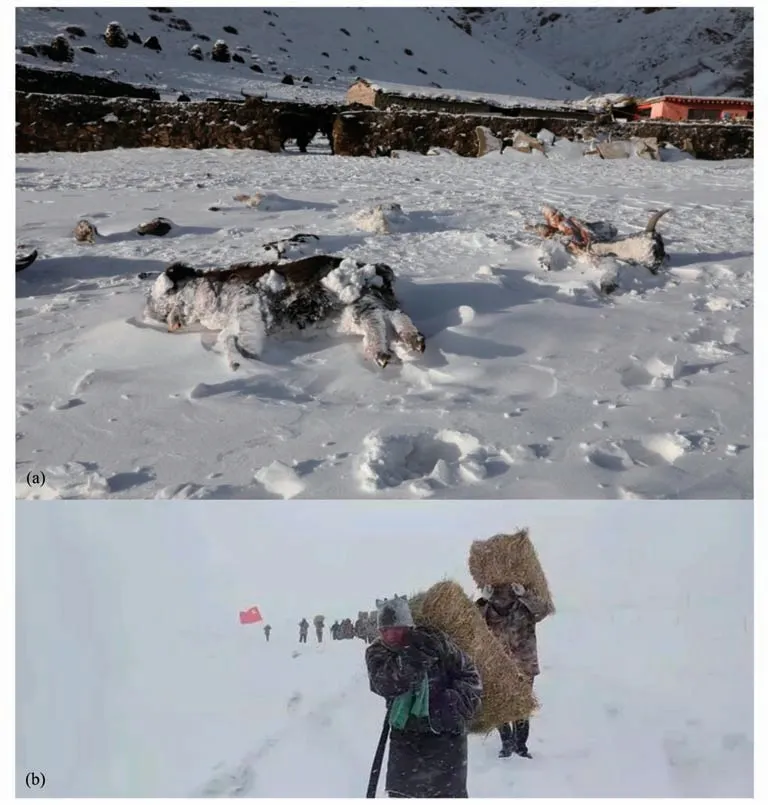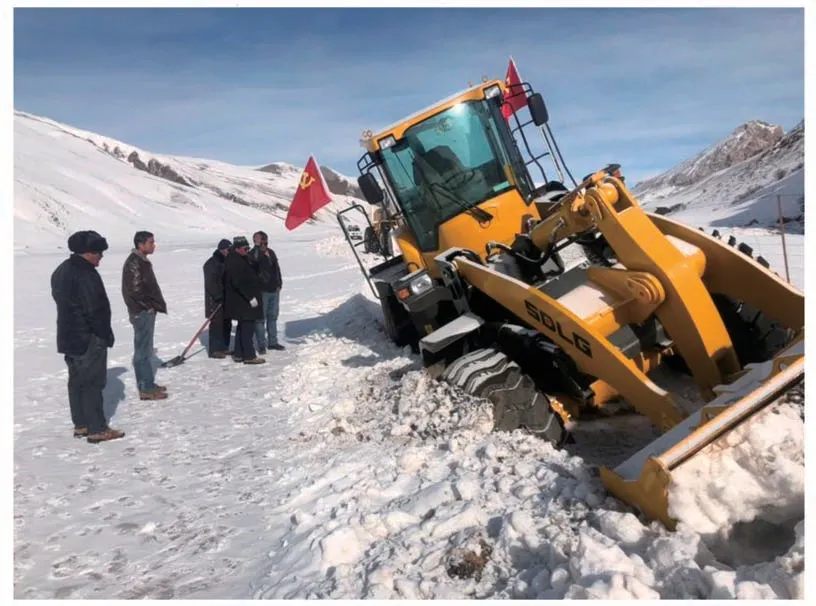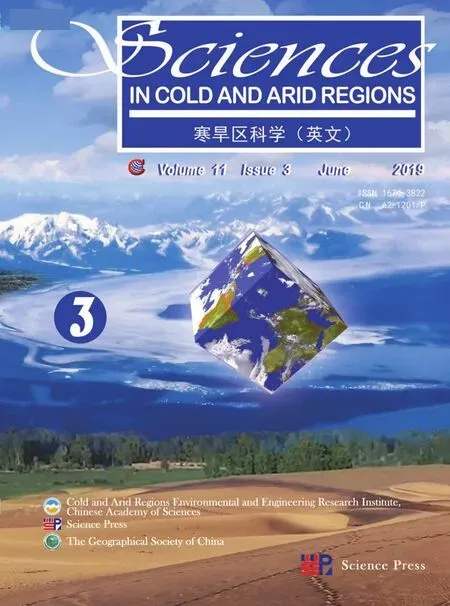Risk prevention and controlstrategies for the severely affected areasof snow disaster in the Three Rivers Source Region(TRSR),China
ShiJinWang,ShengYun Chen,2*,YanQiangWei
1.State Key Laboratory ofCryospheric Science,Northwest Institute ofEco-Environment and Resources,Chinese Academy of Sciences,Lanzhou,Gansu 730000,China
2.QinghaiProvince Key Laboratory ofPhysicalGeography and Environmental Process,Academy ofPlateau Science and Sustainability,QinghaiNormalUniversity,Xining,Qinghai810008,China
3.Key Laboratory ofRemote Sensing ofGansu Province,Northwest Institute ofEco-Environment and Resources,Chinese Academy of Sciences,Lanzhou,Gansu 730000,China
ABSTRACT Historically,frequentand heavy snow disaster(SD)has caused serious livestock death and casualties,resulting in a devastating impact on animal husbandry development in the Three Rivers Source Region(TRSR).From w inter in 2018 to spring in 2019,the largest SD occurred in this area over the past10 years,especially in core zones of the Lancang River Source Region.Field research results show that themain causes of themajor SD includeweak infrastructure(i.e.,roads,communications,warm sheds,and insufficient forage reserve),low rate of domestic animals for sale before the SD,and low loss settlement rate.SD occurrence could furtherly reduce the ability of disaster prevention,m itigation and relief of disaster loss.In the future,heavily affected SD areas should improve the forecasting ability of snow fall incidents,strengthen infrastructure construction,implement grass and livestock balance strategies,optim ize livestock structure,improve loss settlement rate,and develop amodern compoundmodelof animalhusbandry developmentmodel thatcombines breeding,slaughtering and deep processing of animalproduct.
Keywords:Three Rivers Source Region;snow disaster;severely affected area;risk prevention;controlstrategy
1 Introduction
The Three Rivers Source Region(TRSR)of China is a center of high incidence of snow disaster(SD).SD occurs frequently and has become a normalized natural disaster in this region(Wang etal.,2014).Recently,although SD in the TRSR mainly occurswith small-scale disasters(under 600,000 sheep units),the total numbers of livestock deaths have increased year by year.These deaths have revealed the high risk and strong destructive force of the SD.From December 2018 to March 2019,snow fall lasted too long and snow cover got too high in the Yushu and Guoluo Tibetan Autonomous Prefecture located in the TRSR.This has resulted in 57,900 livestock deaths due to the freezing injury at low temperature and the hungry for lack of forage and the conditions of reserve deficiency and road impassablity(e.g.,Figure 1a).This disaster has led to the directeconom ic loss of 0.192 billion CNY.This SD is themost severe in nearly 60 years,especially in the Lancang River region (LRR).Among this region,Zaduo County,"The First County of Lancang River Source",is themost severely affected SD zone in the LRR.SD caused themass death of livestock(yaks)and a certain number of w ild animals such as Gervus albirostris and Procapra picticaudata.Due to this disaster,the M inistry of Emergency M anagement of the People's Republic of China started national class IV disaster emergency response,sent a working group to the disaster area to guide the disaster relief work.Meanwhile,the People's Government of Qinghai Province and the local government have actively deployed disaster relief and post-quake reconstruction work,such as forage supply,road clearing and innocuous disposal of livestock carcasses and so on(e.g.,Figure 1b and Figure 2).As an authoritative scientific research institution on cryosphere disasters and services,the State Key Laboratory of Cryospheric Science,Northwest Institute of Eco-Environment and Resources(CAS)has undeniable responsibility in this SD event.In the first time,the State Key Laboratory initiates a field study on thismost serious disaster in the Zhaqing Township,Zaduo County in the LRR source regions of the Three Rivers Source National Park.

Figure 1 Livestock deaths(a),disaster response(b)in Zaduo County,Yushu Autonomous Prefecture,China.Photoed by TV station of Yushu Autonomous Prefecture
2 M ain reasons of the SD form ation
The density of livestock in the township is small,but the damage incurred from SD included over 95%of the affected area and 50%of livestock mortality rate.Historically,SD occurs frequently in the TRSR,causing serious death and injury of livestock due to lack of forage and freezing injury.This disaster produces a devastating impact on livestock production and development(Wang et al.,2014).Due to the restriction of traditional grazingmethods(e.g.,nomadism and dispersion)and a complicated geographical environment,road networks is antiquated and inconvenient and the telecommunication network is poor.It leads to an extremely low ability to deal with the SD risk.The main causes of this SD event in the TRSR are as follows:1)Conflicts in environmental protection and infrastructure construction producing reduced coping capabilities;2)Fragile ecosystems and insufficient forage reserves producing lim ited prevention capacity;3)A single structure livestock industry resulting in a lack of anti-disaster capacity;4)Low rate of insurance compensation for livestock mortality which affects the confidence of Tibetan herders in raising livestock.
To m itigate the effects of SD and achieve longterm stability,it is necessary to improve the happiness index of herders,continuously maintain social harmony and stability in the Tibetan areas,and effectively improve and protect their livelihood.

Figure 2 Inconveniet road network in Zaduo County,Yushu Autonomous Prefecture,China.Photograph by the staff of Zhaqing Township
3 Policy recomm endations
In the past,emphasiswas placed on the study of snow fall events caused by SD.However,risk identification and controlof snow disaster,disaster prevention and m itigation have gradually become the focus of attention at present.This proactive prevention and control help to m itigate the potential impact of SD on livestock husbandry.Large snow fall events cannot be prevented or overcome,butone can reduce or avoid the risk or loss of SD by some measures including reduction of livestock exposure,m itigation of livestock vulnerability,enhancement of disaster prevention and m itigation capabilities(e.g.,forecasting and warning,reserve fund,anti-disaster infrastructure,medical condition,emergency management capacity,insurance compensation rate)(Wang et al.,2019;Wang and Xiao,2019).Specific policy recommendationsare as follows.
3.1 Improve monitoring level of snowfall events and snow accumu lation periods
To a large extent,reducing or avoiding SD risk depends on effective and accurate forecast information of snow fall events and themonitoring results of snow extent and depth.Therefore,it is urgent to establish and develop an accurateweather forecastsystem for snow fallweather in w inter and spring of the TRSR to improve its forecasting level and service ability.It is the most important preventive measure to prevent and reduce SD risk.A lso,it is necessary to use high-resolution remote sensing to rapidlymonitor snow cover in the TRSR.Combined with the height of grass distribution,we can quantitatively estimate the height about grass buried by snow cover and carry outearly warning of SD.
3.2 Fully implement the deployment of infrastructure construction in SD areas
The occurrence of sever SD during 2018-2019 has produced a sense of inevitability for even more and longer periods of snow cover.A lso,contingency plans are hampered by the lack of infrastructure construction such as road and power networks,communication and warm ing sheds.Among them,warm ing sheds are an important facility for disaster prevention and livestock protection in w inter and spring.In view of this,it isurgent to fully implement infrastructure deployment of telecommunications,road networks,and warm ing sheds in frequent and heavily affected areas of snow disaster in the TRSR to avoid livestock deaths.
3.3 Strengthen the establishment of trans-regional natural and artificial pasture planting bases
Due to geographical conditions,climate and grassland types,it is not suitable for constructing a forage base in the TRSR.Therefore,Nangqian County near the core area of the Lancang River in Yushu Tibetan Autonomous Prefecture,Dari and Gande counties in the source regions of the Yellow River,and Xinghai,Tongde and Guinan counties in Hainan Tibetan Autonomous Prefecture should be used as natural and artificial pasture planting bases.They should be able to provide plentiful forage for the TRSR during extreme SD events.
3.4 Implement the grass-livestock balance strategy,and make rational and efficient use of grassland resources
Fully implementing the dynam ic balance policy of grass-livestock is an important link of management strategy of SD risk.When the overloading rate is low,there ismore livestock feed on grassland per unit area.In contrast,when food intake reduces,the ability to cope with SD w ill greatly reduce.with the influence of alpine climate,characteristics of the short grow ing season and the long withering period of grassland in this area produces an imbalance of seasonal pasture and prom inent contradiction between grass and livestock.According to parameters such as grass yield,livestock demand,seasonal variation and difference,the theoretical carrying capacity of livestock in w inter and spring,the availability of grassland and the main basis of enclosure feeding period should be determ ined.
3.5 Optim ize the structure of herds and speed up the cycle of herd turnover
Rational herd structure and hardy livestock varieties are the basis of anti-disaster andm itigation in w inter and spring pastoral areas.Themain victims of severe SD are large sized livestock that include sick,immature and weak animals.The population structure of livestock needs to be optim ized for the difference of feeding habits of different livestock in the snow fall period.A large number of livestock should be raised in the breeding season,so that the summer-autumn pasture is used at the appropriate time,and the rate of domestic animals for sale should be accelerated before w inter and spring seasons to avoid livestock loss caused by SD.
3.6 Raise loss compensation rate and explore the rationalized insurance mechanism
A lthough the SD affected areasof TRSR have purchased commercial insurance,the loss ratio is less than 20%of total econom ic loss of livestock death.Therefore,it is urgent to establish or improve the tiered insurance mechanism with diversified investmentmodes such as government support and foreign investment for SD in the TRSR.It is necessary to encourage commercial insurance companies in order to actively participate in insurance business,and to reduce their business taxes to compensate as much as possible for the econom ic losses caused by SD.
3.7 Develop a way of composite and diverse animal husbandry
A ffected by the natural environmentand traditional grazing habits,current animal husbandry is still in the primary development stage of breeding in the TRSR.This pattern is unable to cope with huge econom ic losses caused by SD.It is urgent to strengthen the linkage between pastoral areas and urban areas,as well as the all-w in cooperation mode between herdsmen,enterprise and governments,and to build a complex,multi-variable and circularmodern system of animal husbandry including feeding,dairy products,meatand sale.The green way to animalhusbandry developmentw ill effectively reduce the potential impact of snowstorms.
Acknow ledgments:
This work was supported by Open-ended Fund of Qinghai Province Key Laboratory of Physical Geography and Environmental Process(2018-QZH-K01)and National Natural Science Foundation of China(41701505,41871064)and the foundation of PHD development in Yichun University(201-3360118009).
 Sciences in Cold and Arid Regions2019年3期
Sciences in Cold and Arid Regions2019年3期
- Sciences in Cold and Arid Regions的其它文章
- Vice p resident Zhang visited Cryosphere Research Station in A laska,Northwest Institute of Eco-Environment and Resource,Chinese Academ y of Sciences
- A landscapem anagementanalysis framework and its prelim inary app lication in Ejina Oasis,Northwest China
- Stem radialgrow th indicate the optionsof species,topography and stand management for artificial forests in thewestern Loess Plateau,China
- MODISobserved snow cover variations in theAksu River Basin,Northwest China
- Assessing the im pactsof ecological-living-productive land changeson eco-environm entalquality in Xining City on Qinghai-Tibet Plateau,China
- Variation and relationship between soilm oisture and environm ental factors in the source region of the Yangtze River from 2005 to 2016
